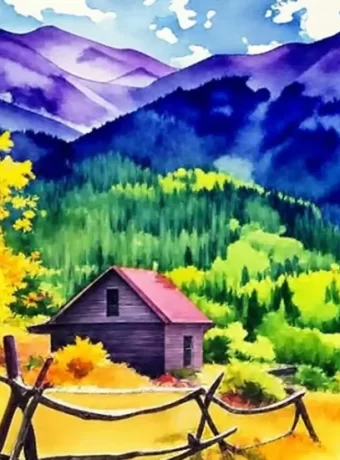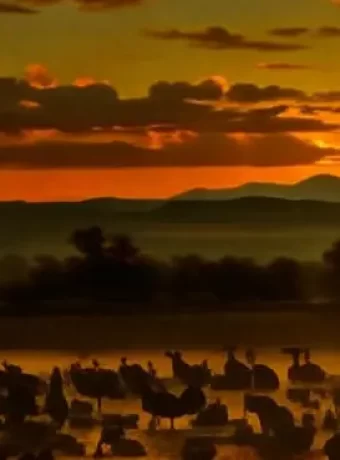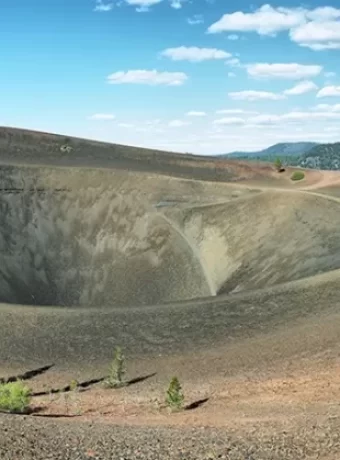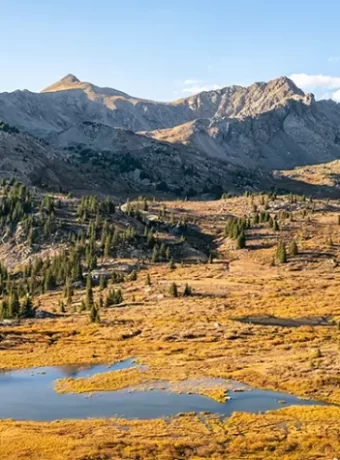Colorado Ghost Towns: Historic Adventures Await
Colorado’s landscape is dotted with relics of the past, where dreams were once as abundant as the gold and silver that lured prospectors west. Among these memories stand Colorado Ghost Towns, silent yet powerful reminders of human tenacity and nature’s reclaiming force. By exploring these ghost towns, you’ll connect with stories etched into crumbling log cabins and abandoned mining equipment.
You’ll uncover places like St Elmo, standing guard over tales of a bygone era, or wander through Ashcroft, pondering its swift rise and fall in the shadows of Aspen trees. These sites aren’t just decaying buildings; they’re gateways to understanding Colorado’s rugged history—perfect for those who seek adventure off beaten paths.
Dive deep into America’s frontier legacy; witness firsthand how settlements like Dearfield grappled with Dust Bowl challenges while Animas Forks teeters high amidst mountain peaks—a testament to miners’ ambitions against nature’s backdrop.
Besides climbing 14ers, touring ghost towns in Colorado was one of the best past times. Exploring history. Keep in mind another cool aspect of Colorado ghost towns is there is a really cool hikes and trailheads at just about everyone of them.
Table Of Contents:
- Discovering the Echoes of the Past in Colorado’s Ghost Towns
- The Best-Preserved Ghost Towns to Witness Colorado’s History
- Animas Forks – A High Altitude Mining Marvel
- Independence – The Gold Rush Relic Frozen in Time
- St. Elmo – A Snapshot of 19th Century Daily Life
- Exploring Larimer County’s Forgotten Settlements
- Teller City – Echoes of Log Cabins and Saloons
- The Alluring Decay at Capitol City
- A Glimpse into Eastern Plains’ Last Chance
- The Rich Tapestry Behind Buena Vista’s Ghostly Facades
- FAQs in Relation to Colorado Ghost Towns
- Conclusion of Colorado Ghost Towns
- Ghost Towns in the Rockies, Hikes to Fly Fishing
Discovering the Echoes of the Past in Colorado’s Ghost Towns
It’s a treasure trove for history buffs, where ghost towns whisper tales from a time when miners etched their dreams into the rugged terrain. With over 1,500 ghost towns scattered across the state, only about 640 stand today in varying states of decay and preservation.
Ashcroft and Dearfield are two such places that serve as poignant reminders of both prosperity and struggle—stories written into their remaining buildings. In Ashcroft, visitors can walk through an area once bustling with activity during Colorado’s silver mining boom—a stark contrast to its quiet present-day existence.
The town boasts several structures on the National Register of Historic Places. The remnants paint a picture of life when it was filled with hope before succumbing to economic downturns brought on by falling silver prices after peaking at nearly 3,500 residents.
In contrast stands Dearfield—the embodiment of African American settlers’ aspirations for a better life through agriculture on Colorado’s Eastern Plains—but ultimately becoming one among many casualties claimed by harsh winters followed by dust storms that ravaged communities during the Great Depression era.
Colorado’s tourism site offers deeper insights into these narratives etched onto landscapes where historical societies strive to preserve what remains.
Ashcroft – The Silver Queen’s Shadow
Nestled amidst forests near Independence Pass lies Ashcroft—an emblematic shadow cast by its prosperous past. Once rivaled only by Aspen itself thanks largely due to hefty deposits discovered nearby which attracted thousands seeking fortunes overnight; now serves instead silent testament rapid growth decline all too common amongst frontier settlements reliant single resource economies back then like so many others dotting region known today simply ‘Ghost Town Trail.’
Tourists visiting this part may explore various historic sites including former post office or even stay night hotel refurbished maintain period-specific authenticity while learning how community thrived short-lived span before inevitable bust left behind nothing but echoes once vibrant streets lined wooden skis makeshift escape routes used those fleeing collapsing market conditions late nineteenth century onwards.
Dearfield – Dreams Deferred by Dust and Depression
Heading further east from the mountain peaks, where plains stretch far and wide beneath the big sky country, lies Dearfield. This town symbolizes dreams deferred and the challenges African Americans faced as they moved westward hoping to cultivate fertile land. Their goal was to secure a piece of the elusive “American Dream” for themselves and future generations. Sadly, despite their initial success, farming ventures proved unsustainable in the face of environmental and economic adversities. Eventually, this led to abandonment altogether. But even so, memories of resilience and determination linger on—casting light not just on hardships encountered but also celebrating an enduring spirit.
Step back in time with a visit to Colorado’s ghost towns, where you can walk the silent streets of Ashcroft and feel the boom-and-bust echo of its silver mining past or reflect on Dearfield’s resilient African American settlers who chased their dreams against all odds.
The Best-Preserved Ghost Towns to Witness Colorado’s History
Step back in time as you walk through some of Colorado’s best-preserved ghost towns, where buildings still stand as monuments to bygone eras and stories waiting to be retold.
Time travel isn’t just a fantasy when you stroll through the best-preserved ghost towns of Colorado. These spots are like history books in 3D, where every creaky floorboard and rusted nail has a story to tell. Take St. Elmo for instance—considered one of the top spots with buildings so intact, you’d half expect a dusty miner to tip his hat as he passes by.
In these places, it’s easy to picture the hustle and bustle that once filled the streets: children darting between log cabins on their way home from school, or miners discussing their latest haul at local saloons over shots of whiskey. It’s not just about seeing; it’s about feeling connected to those who came before us.
If walls could talk, those in St. Elmo would surely speak volumes about its past life as an active mining community where general stores served up supplies and post offices were lifelines connecting folks with distant loved ones. Nowadays, visitors can peek into this chapter of American West lore thanks largely due to preservation efforts that keep tales alive well beyond faded photographs or yellowing pages.
Ashcroft – The Silver Queen’s Shadow
Just down Independence Pass lies Ashcroft—a town which now quietly whispers secrets from its silver mining days under Aspen trees’ watchful eyes Aspen Historical Society. Here stood structures brimming with dreams during an era defined by boom-and-bust cycles unique to mountain towns chasing veins rich with precious ore beneath rugged peaks.
This place boomed faster than wildfire but was deserted almost overnight when silver lost its luster after market crashes took wind out sails powering such economies back then—but don’t let looks deceive. Although today only wooden skeletons remain among high-altitude meadows lining Castle Creek Road, they’re still mighty enough narrators recounting what life was like amidst unforgiving wilderness conditions yet thriving social scenes alike.
Dearfield – Dreams Deferred by Dust and Depression
Beyond Denver along U.S Route 34 stretches Dearfield—the embodiment of resilience facing adversity head-on despite Dust Bowl winds trying hard erasing hopes African Americans planted here while fleeing Jim Crow South searching greener pastures literally figuratively both.
It wasn’t always barren landscapes greeting explorers either because although hardscrabble farming tested limits, human spirit and tenacity prevailed. This grit allowed them to forge a tight-knit community worthy of note—even if eventually all succumbed.
Step into Colorado’s ghost towns and feel the Old West come alive. Stroll through places like St. Elmo, where buildings are so well-kept you can almost hear echoes of miners’ chatter.
Ashcroft whispers tales of its silver rush under Aspen skies, a silent narrator to the rise and fall of mining dreams.
In Dearfield, discover the enduring spirit of African American pioneers who faced down Dust Bowl challenges with unyielding hope.
Animas Forks – A High Altitude Mining Marvel
Journey to Animas Forks, nestled high in the San Juan Mountains, where large-scale mining operations left behind an architectural legacy at nearly 11,000 feet elevation.
The Architectural Legacy Left by Miners
Explore Animas Forks, a former mining hub with over 30 active mines during its peak. The preserved buildings offer a glimpse into life from another era, from bay-windowed residences to rugged outposts.
Capturing Moments Frozen in Time
Step into the past in Animas Forks, where silver once flowed and amenities like a post office and general stores served the community. Discover the enduring beauty and resilience of this ghost town.
Independence – The Gold Rush Relic Frozen in Time
Imagine stepping into a world where the clink of pickaxes and the dreams of fortune-seekers once filled the air. Independence, nestled high on Colorado’s scenic byway known as Independence Pass, is that place—a town literally frozen in time.
The year 1882 saw this gold rush gem teeming with life; its population soared to 1,500 residents, all hungry for prosperity. But Mother Nature had other plans. Fierce winters whipped through the settlement, sending temperatures plummeting and spirits along with it. As gold veins thinned out like winter rations, many settlers strapped wooden skis onto their feet—crafted from their own homes’ lumber—to glide down mountainsides towards greener pastures.
In today’s visits to Independence you’ll find silence has replaced bustle—but not without whispers of resilience that still echo among abandoned buildings etched against stark alpine skies.
A Resilient Community Against Harsh Winters
The people who carved out a living here were no strangers to adversity; they faced it head-on when snows blanketed every cabin roof deep enough to bury hopes under layers of white desolation. Yet even now, those dilapidated structures stand defiantly amid gusts sweeping across empty streets—their existence testament to tenacity in extreme conditions.
You can almost hear tales waft over windswept ridges about how these miners lived: drawing tight community bonds within log walls or seeking warmth at a local tavern before returning home via flickering lamplight beneath vast starry nightscape above Continental Divide vistas only miles away from Aspen Historical Society’s curated archives which detail such rugged lifestyles (Aspen Historical Society).
Skiing Into History – The Great Escape on Homemade Skis
No tale better captures Independence’s spirit than that dramatic escape during one especially brutal winter circa late-1800s when food supplies dwindled along with patience—and survival instincts kicked into full gear resulting in makeshift ski crafting using house materials available after doors got buried first then hope next but never ingenuity nor determination among inhabitants there.
This wasn’t just an exodus; it was transformational—an entire town dismantling itself piece by piece so its people could survive elsewhere if not thrive right there anymore. Because sometimes moving forward means leaving something behind, but always remembering what sparked that initial growth—what might spark it again. That’s why historians hold these sites in high regard: they offer lessons to future generations about human resilience against the overwhelming power of nature, lessons that often surpass what textbooks can convey. Through their stories, we gain insight into our collective endurance and adaptability throughout history.
Step into Independence, where the Gold Rush still echoes. Once a bustling hub with 1,500 souls braving harsh winters for gold, now stands as a silent testament to their grit. Explore this ghost town and feel the whispers of its past inhabitants’ unyielding spirit against nature’s might.
St. Elmo – A Snapshot of 19th Century Daily Life
Wander through St. Elmo’s remarkably preserved streets lined with wooden structures ranging from general stores to residential cabins—each corner holding echoes of daily life from over a century ago.
St. Elmo is one of Colorado’s most accessible and well-preserved ghost towns. Nestled in the sawtooth mountains, this town offers a glimpse into the wild West of the 1800s. As you stroll through the silent streets, it’s easy to imagine the gritty chapters of history that unfolded here.
The air in St. Elmo is filled with untold stories. The wooden structures have stood the test of time, with general stores still displaying long-forgotten goods and residential cabins sitting eerily empty. Every corner seems to whisper secrets from the past.
If the walls could talk, they would share tales of miners seeking fortunes deep underground and the daily bustle of horse-drawn wagons along Main Street. The past is alive in St. Elmo, with creaking boardwalk planks that transport you back to the lives of residents over 100 years ago.
The area surrounding St. Elmo was rich in silver. To the south the ghost town of Hancock and the Alpine Tunnel a narrow gauge railroad that ran to Leadville. This a great hike and part of the Continental Divide and Colorado Trails.
A Peek Inside Preserved Buildings
Walking among the preserved buildings in St. Elmo is a captivating experience. These structures stand as a testament to resilience in the face of harsh winters and changing times. It’s like flipping through the pages of a history book that has come to life. Peer inside the cabin remains or admire the artifacts left behind by the pioneers who once called this place home. The silence is broken only by the sounds of crunching snow or distant mining activity.
The former general store now serves as a museum and a hub for the informal historical society. Visitors can get a closer look at the items used by the pioneers who lived high above sea level, facing relentless winters. It was these winters that drove many away, but the spirit of hope and determination remains.
Glimpses into Everyday Lives
St. Elmo offers glimpses into the everyday lives of its past inhabitants. The stunning scenery and rugged terrain surrounding the town added to the challenges they faced. Life above the tree line required quick adaptation and strong community ties. Even avalanches couldn’t break their spirit. However, as the mining boom faded, the population dwindled, leaving behind echoes of ambition.
Preservation efforts have allowed us to experience firsthand the tangible remnants of St. Elmo’s history. It’s more than just reading about the past; it’s a chance to walk back in time. These places serve as touchstones to the American spirit of adventure and remind us of our shared heritage, inspiring future generations with lessons from yesteryear.
Stroll through St. Elmo and feel the whispers of history with every step. This ghost town is a time capsule, letting you touch the past through preserved buildings and silent stories etched in wood.
Step into St. Elmo’s general store turned museum for an intimate look at pioneer life high above sea level, where hope thrived despite harsh winters.
In St. Elmo, everyday life from over a century ago isn’t just read about—it’s experienced as you walk among buildings that echo resilience and community spirit against all odds.
Exploring Larimer County’s Forgotten Settlements
In the rolling foothills of Colorado, where nature has reclaimed its dominion, lie echoes of Larimer County’s forgotten settlements. Stout and Virginia Dale are not just names on a map but portals to an era long past. As we walk through these areas today, we tread over stories submerged under Horsetooth Reservoir or nestled within the remnants of a stagecoach stop.
Stout once bustled with life before being evacuated in the late 1940s. The construction of Horsetooth Reservoir sealed its fate, submerging it beneath waters that now reflect only skies and surrounding hills. Though you can’t visit Stout itself anymore, its memory ripples across time whenever one gazes upon this vast body of water—a testament to both human endeavor and sacrifice for progress.
A bit further north lies Virginia Dale—an enduring fragment from our frontier history where travelers once stopped along their arduous journeys westward. Even though most structures have succumbed to time’s relentless march, some buildings refuse to fade away quietly into obscurity—like silent sentinels bearing witness to countless tales whispered by windswept plains.
The history soaked ground here is rich with more than just soil; it holds layers upon layers of lives lived fiercely against elements both natural and man-made: stoic homesteaders forging existence out in untamed lands during the Gold Rush frenzy; hopeful settlers braving harsh winters while dreaming big dreams like those who established towns such as Teller City—with log cabins lining streets alongside nearly thirty saloons at its peak—and Capitol City which briefly flourished thanks to affluent residents aspiring for wealth amid rugged terrain.
To explore these places is akin to stepping into photographs faded by age yet vibrant with storied pasts—one can almost hear laughter spilling from saloon doors or see shadows flitting between crumbling walls if they listen closely enough among whispering aspen trees…
Teller City – Echoes of Log Cabins and Saloons
If you’re looking for adventure off beaten paths then venture towards Teller City’s alpine landscape; what remains speaks volumes about boomtown spirit gone silent after thriving fervently back when mining was king hereabouts… You’ll find no grandeur left behind save for poignant stillness pervading empty spaces where hundreds once lived full lives amidst merriment provided by ample drinking establishments until early 1900s economic shifts turned booms into ghostly whispers lost amongst pine-scented air.
Step back in time at Larimer County’s ghost towns, where the waters of Horsetooth Reservoir and windswept plains tell tales of Colorado’s rugged past—from Stout’s submerged stories to Virginia Dale’s enduring structures. Teller City whispers its history through remnants among pines.
Teller City – Echoes of Log Cabins and Saloons
Imagine stepping into a scene from the Wild West, complete with log cabins and saloons. That’s Teller City for you—a true embodiment of boomtown spirit gone silent. This Colorado ghost town once bustled with life in its alpine landscape, where hundreds lived seeking fortune.
The remains of nearly 30 saloons hint at lively nights filled with tales of prospecting successes and failures alike. The air whispers stories from over a century ago when miners flooded this spot by the early 1900s, searching for what they hoped would be their big break.
Now let me take you through these silent streets that tell such vivid stories without uttering a word—through Teller City’s history, preserved not just in buildings but in the very essence of the place.
Venture into Teller City’s Alpine Landscape
In an area known for rugged peaks and thick aspen forests lies Teller City—a reminder of Colorado’s rich mining past. A visit here is like flipping through pages of history without touching a book; it’s all around you—the abandoned structures standing resilient against time.
A walk down what was once Main Street might lead to thoughts about those who came before us, lured by silver veins deep beneath the mountainside. Now, only wooden relics remain where laughter used to echo off log walls under high-stakes poker games.
Hundreds Once Lived Amongst Log Cabins and Saloons
Picture this: hardy souls braving harsh winters inside simple yet sturdy cabins built by hand—an architectural testament to determination. It wasn’t easy living up here back then; folks were tough as nails though because that’s what survival looked like on America’s frontier land at its peak near the early 1900s.
The town flourished briefly thanks to ambitious men and women making do despite isolation so severe even supply trips could turn perilous quickly if weather turned foul or paths proved treacherous.
But eventually time marches on—as does progress—and towns either adapt or fade away into obscurity which sadly became fate for many such settlements across the state, including ours right here too after the boom went bust. It left behind echoes and memories we can still hear today if we listen closely enough while wandering amongst old general stores and crumbling facades. The former glory days have long since passed us by, now forevermore captured perfectly within the picturesque setting nestled between snow-capped mountain tops. With its stunningly beautiful scenery that might just make your heart ache a little bit, Teller City welcomes every visitor to pass through its gates and discover all of its hidden treasures.
Step into Teller City and walk through the Wild West, where log cabins and saloons whisper tales of prospectors’ dreams. Here, history isn’t read; it’s felt in the remains of a town that thrived on ambition but now stands as a scenic relic of Colorado’s mining saga.
The Alluring Decay at Capitol City
Capitol City once bustled with dreams as lofty as the peaks that cradle it. But now, visitors witness a faded grandeur where silence fills the air and each building tells its own story of isolation and abandonment. This ghost town’s brief glory days saw affluent residents reaching for wealth amid rugged terrain.
In those days, ambition wasn’t enough to keep a city alive. When you stroll through what remains of Capitol City, imagine hearing the echoes of prosperity against an unforgiving landscape. The place was more than just buildings; it was about people who braved odds in hopes of striking rich.
Nestled high up where oxygen runs thin and dirt roads turn to trails, this site demands respect—not only for nature’s might but also for human tenacity. With every weathered plank or crumbling smelter stack comes a narrative that transcends time—a collective memory marking both triumphs and trials faced by former inhabitants.
A Snapshot in Time
It’s not often we get to step directly into history’s pages like we can here at Capitol City. At one point thriving with life—though briefly—it now offers an almost palpable sense of longing from when affluence seemed possible amidst mountains demanding resilience from all who dared settle there.
This ghost town paints a picture clear enough: no matter how high your aspirations soar or how sturdy your foundations are laid down if community spirit wanes under harsh conditions, so too will the settlement itself fade away into obscurity until nothing but tales remain among dilapidated structures awaiting rediscovery by curious souls seeking connections with our past lives.
An Invitation to Explore
If these silent streets could speak they’d recount stories about miners pulling resources straight from earth’s grip while families carved out existences on steep slopes overlooking valleys far below where streams whispered secrets known only to wildflowers swaying gently alongside them—an ecosystem entirely unaware yet intrinsically linked together within this grand cycle called life which continues regardless even after humans have long since departed scenes such as these across Colorado’s historical landscape full intricate tales waiting patiently be uncovered again anew by explorers today hungry knowledge understanding what truly means survive thrive against odds never fully stacked their favor begin with…
Colorado’s tourism site beckons those willing to take a journey back in time to see firsthand the relics of once ambitious ventures. Surrounded by natural beauty that is both breathtaking and formidable, it allows for a glimpse into an era forever etched in stone, metal, and wood. These enduring symbols stand as a testament to the strength, courage, and determination that shaped the very fabric of the state’s identity. It still stands proudly despite years of progress marching onward—ever forward—leaving places like Capitol behind but always remembered as cherished parts of our shared heritage woven tightly into the cultural tapestry of an entire nation built upon foundations laid by brave men and women who came before us and forged paths toward futures beyond.
Capitol City captures the essence of Colorado’s mining past, where silence now speaks volumes about human dreams and nature’s power. It beckons explorers to walk its streets, feel history underfoot, and honor those who once called it home.
A Glimpse into Eastern Plains’ Last Chance
Amid the vastness of Colorado’s Eastern Plains, you’ll find the sparse remains of Last Chance—a ghost town that stands as a testament to human resilience. This area, more known for its absence than presence, whispers stories of those who dared to settle on these open lands.
Last Chance might not have grand structures or legendary tales like other historical settlements, but it offers something just as compelling: an unfiltered look at the American frontier spirit. The town’s modest ruins speak volumes about its past inhabitants’ struggle against unforgiving elements and economic hardship.
What once held promise now lays mostly bare under expansive skies—remnants include foundations where homes stood and fragments of daily life scattered across the plains. For anyone seeking insight into America’s rural heritage and pioneer courage, this spot is worth exploring Colorado Ghost Towns.
The Echoes Of Optimism In A Land Of Extremes
Imagine arriving in Last Chance full of hope during times when finding fortune was as much about survival as it was prosperity. Here on Colorado’s frontier land—an environment marked by extremes—settlers were lured by promises only to face isolation amidst one of nature’s most challenging landscapes.
The remaining buildings may be few but they echo with stories from decades ago when this area buzzed with activity fueled by dreams which would later succumb to Dust Bowl-era tribulations and Great Depression woes.
Lasting Lessons From Fading Footprints
In places like Last Chance, history isn’t told through bustling streets or towering monuments; instead, it lies quietly within each weather-worn artifact left behind. Visitors can glean lessons from what little endures here—the outlines where Main Street businesses once thrived reveal how quickly fortunes changed for those chasing better lives out West during tumultuous times in our nation’s story.
Though modern-day adventurers won’t find busy shops or services along these empty fields anymore they’ll encounter a three-quarter-mile loop trail guides visitors through remnants offering a tangible connection back through time allowing reflection upon perseverance even when Mother Nature dictates otherwise.
A Solemn Reminder To Contemporary Explorers
To stand among Last Chance’s meager vestiges is both humbling and enlightening—a reminder that although communities may fade, their legacy persists, woven tightly into America’s broader narrative. These markers serve as a poignant nudge of the impermanence yet enduring impact of our collective history.
Explore Last Chance, a Colorado ghost town that tells the story of American grit. With few ruins left, it’s a stark reminder of pioneer struggles and dreams undone by harsh realities.
Last Chance offers a rare peek into rural America’s past and the tenacity of those who tried to tame the land against all odds.
The Rich Tapestry Behind Buena Vista’s Ghostly Facades
Buena Vista holds a unique charm, where the whispers of yesteryear linger among derelict structures. This Colorado gem beckons adventurers and history buffs alike to explore its storied streets. The town’s past is visible in the silent post offices and general stores that stand as relics against stunning mountain vistas—a biker’s delight off beaten paths.
What once bustled with life during Colorado’s gold rush now offers fragments for exploration. These ghostly facades are not mere buildings; they’re storybooks carved in wood and stone, narrating tales of miners who dreamt big under Buena Vista skies. It’s a place that marries history with outdoor pursuits—just steps away from trails perfect for biking enthusiasts craving an adventure beyond their usual terrain.
Dawn Wilson Photography captures this intersection of natural beauty and historical intrigue through a lens that makes you feel part of the landscape itself—the perfect complement to any visit seeking depth over breadth.
Buena Vista, Salida, St. Elmo, Cottonwood Pass, I could go on and on. I spent a lot of weekend hiking, fly fishing, and exploring this area.
FAQs in Relation to Colorado Ghost Towns
What is the most popular ghost town in Colorado?
St. Elmo tops the list as Colorado’s crowd favorite, thanks to its well-kept buildings and picturesque setting.
What is the most famous ghost town?
Bodie, California grabs fame for its preserved state and authentic Wild West ambiance.
Is it illegal to explore a ghost town?
You can legally explore many ghost towns, but always check for private property signs or access restrictions first.
What ghost town in Colorado has a saloon?
Teller City once buzzed with 30 saloons; their spirit lingers despite the silence that now reigns there.
Conclusion of Colorado Ghost Towns
Embarking on a journey through Colorado’s 20 best ghost towns is like walking through history. You’ve witnessed the rise and fall of Ashcroft, felt the grit of Dearfield’s pioneers, and stood in awe at Animas Forks’ high-altitude legacy.
From Independence’s frozen-in-time charm to St. Elmo’s daily life snapshot, these ghostly echoes have spoken. Larimer County has revealed its forgotten tales; Teller City has whispered stories from log cabins long silent.
The allure of Capitol City remains undeniable, just as Eastern Plains’ Last Chance captures resilience amidst absence. Buena Vista bridges past and present with adventures that extend beyond its historic facades.
Colorado’s 20 best Ghost Towns aren’t just ruins—they’re monuments to endurance, dreams undeterred by time or elements. Take this history home; let it inspire your own enduring spirit in whatever frontier you face next.
Ghost Towns in the Rockies, Hikes to Fly Fishing
Wyoming, Montana, Idaho all have a rich mining and ranching history with ghost towns dotting the landscape. Or given any thought to fly fishing the world or backpacking Africa? The island of Iceland offers some the best fly fishing for Char, Trophy Brown Trout and Salmon. A history tour fly fishing Italy, starting in the Dolomite’s, wine country, and ending on the Island of Sardinia.







